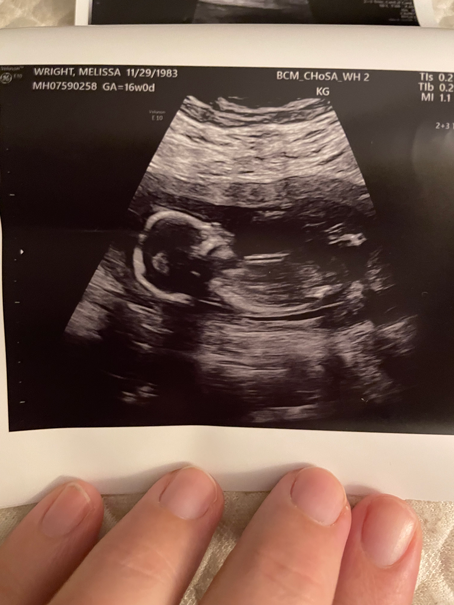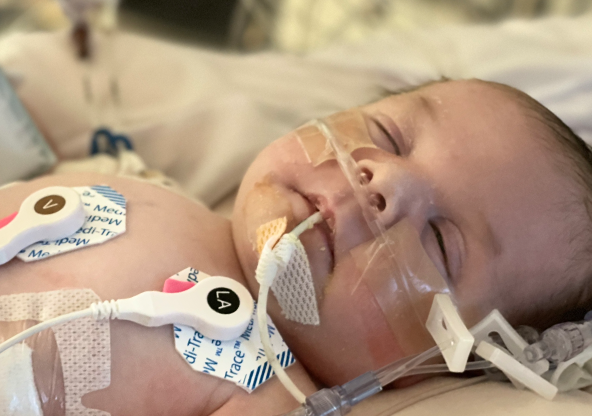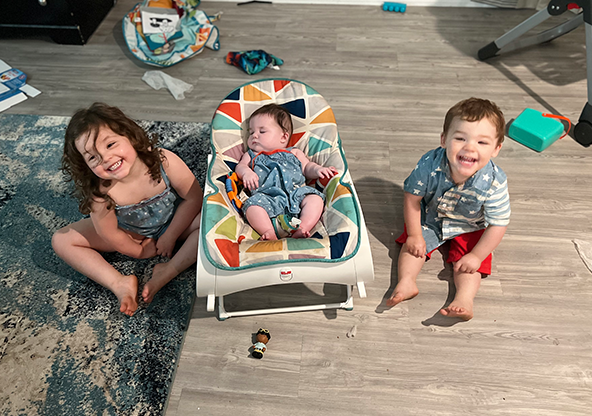A Rainbow Baby’s Fighting Heart
When Melissa Wright found out she was pregnant in June of last year, she and her husband were ecstatic. Already parents to a young son and daughter, the couple always knew they wanted one more child, but earlier that same year, Melissa had suffered a miscarriage, so the news was especially joyful for their family.
Melissa’s first trimester was smooth, and by the time she reached her 20-week ultrasound appointment, she was feeling more and more confident about the day she would soon welcome their rainbow baby, a little girl, into the world.
Because of her age and previous miscarriage, Melissa had regular appointments with a Maternal Fetal Medicine specialist for extra monitoring. During her 20-week ultrasound, which measures the growth and development of the baby through a comprehensive scan, she noticed that her technician spent extra time examining the heart. Not long after, her Maternal Fetal Medicine specialist sat Melissa and her husband down and explained that there was some concern about the baby’s development.
Related Content
“She said the left side of the heart was measuring a little small,” Melissa recalled. “My husband and I were both in shock. We thought, ‘How can anything be wrong with our baby?’”
Melissa’s specialist referred her to pediatric cardiologist Dr. Monesha Gupta, who is the director of the Fetal Cardiology Program at CHRISTUS Children’s.
“Dr. Gupta performed a fetal echocardiogram on our baby to get as much information about her condition as possible,” Melissa said. “Afterwards, she came back and said that it was what we had been told before, that the left side of her heart was small, but the good news was that all of her chambers were working nicely and that the flow in her heart was good.”
The news was promising, but Dr. Gupta cautioned that they weren’t out of the woods completely.
“Dr. Gupta said she would continue to track our baby’s development and that although she was optimistic she may never need surgery, she wouldn’t have all the answers until after our baby was born,” Melissa said.
Dr. Gupta monitored Melissa and her baby closely for the remainder of her pregnancy. Through additional fetal echocardiograms, Dr. Gupta could confirm that the baby’s overall growth and development were on track. Because Melissa had prior C-sections, she and her doctors decided it was safest for her to have this baby via C-section as well, especially with the full condition of her tiny heart unknown.


And so, at 39 weeks gestation, baby Adeline was born at CHRISTUS Children's in San Antonio.
“She came out crying and with a full head of hair,” Melissa recalled. “I got to see her for just a second before they took her to the NICU. My husband and I had already agreed ahead of time that he would go wherever she went, so I was glad to know he was with her.”
Shortly after, Melissa developed postpartum preeclampsia, which can happen after giving birth and is associated with a sudden increase in blood pressure. As her care team worked to stabilize her, another team of specialists were in the NICU with Adeline.
“That evening, the cardiologist came to visit me and explained everything that was wrong with Adeline’s heart,” Melissa recalled. “We also learned that she would need surgery after all.”
Adeline had coarctation of the aorta, which is a narrowing of the aorta, the large blood vessel that carries oxygen-rich blood into the body. According to the Centers for Disease Control and Prevention (CDC), approximately one in every 1,800 babies born in the U.S. each year have this condition. Adeline also had a bicuspid aortic valve, which means the aortic valve had only two small flaps instead of the typical three, which can interfere with the heart’s pumping mechanisms.
Melissa, recovering from the C-section herself, felt anxious for her newborn baby, but she knew Adeline was in good hands, and that her heart was in need of repair.
“Essentially, my heart was pumping for hers when she was in the womb,” Melissa said. “There was no question she needed surgery, but I hated the idea of having my baby placed on a heart bypass machine. She was just so tiny.”
A few days before the surgery, Dr. Daniel Nento, a pediatric cardiothoracic surgeon with The Heart Center at CHRISTUS Children's, called Melissa with some welcomed news.
“He called to tell us that her aortic arch was larger than initially anticipated”,” Melissa said. “It was tiny, just a few millimeters, but large enough for him to work with. Best of all, it meant she met the minimum requirement to not have to have open-heart surgery.”
Melissa was told that instead, she could undergo a lateral thoracotomy to repair the coarctation of the aorta.
Melissa and her husband were thrilled that their baby would not need to be put on cardiopulmonary bypass or undergo as invasive a procedure on the heart muscle itself, as they previously feared. Instead, at 11 days old, Dr. Nento performed the lateral thoracotomy without cutting any of the chest muscle, which would allow for Adeline to recover much faster. During the procedure, he removed the narrow portion of the arch and reconstructed the two ends so that blood would flow normally through the aorta.
“It is really scary seeing your daughter with the breathing tube in and all these medicines going into her, but she did great,” Melissa said. “She was in the PICU for a few days and then returned to the NICU.”

The surgery was a success, but baby Adeline struggled with feeding and eventually developed an aversion to eating. At the end of April, doctors inserted at gastrostomy tube (G-tube) to help her receive the nutrients she needed to continue growing. Melissa said that she will forever remember the amazing care provided by Dr. Maria Pierce, M.D., a perinatal-neonatal medicine physician with CHRISTUS Children's NICU in San Antonio.
“Dr. Pierce was wonderful. She always gave us the facts and didn’t sugarcoat anything, and she called regularly to let us know how Adeline was doing and she was always there to answer any of our questions,” Melissa said. “I also want to recognize our fabulous NICU nurses. It was nice knowing that she was in great hands when we were not able to be there for Adeline.”
All in all, Adeline spent 67 days in the hospital before she was able to go home.
“Getting her to eat on her own is now her biggest hurdle,” Melissa said. “It’s scary for us. I was able to breastfeed my other two kids, so her having a G-tube is a whole different world.”
Melissa said she has been so thankful for the support at The Children’s Hospital of San Antonio, and that they have connected her with resources and other parents going through similar journeys.

“Everyone has been so great. The nurses, the doctors, the respiratory therapists, even the custodial staff,” Melissa said. “You would see them time and again and they would just stop to talk and ask how the baby was doing. It’s not their job, but you could tell they had an interest and they cared, and that really meant a lot.”
Although Adeline still has hurdles ahead, she is a fighter who is loved beyond measure, and her parents are full of hope and faith.
“It’s been overwhelming, but we’re so thankful for our baby girl, and already we’ve seen so many miracles,” Melissa said.

